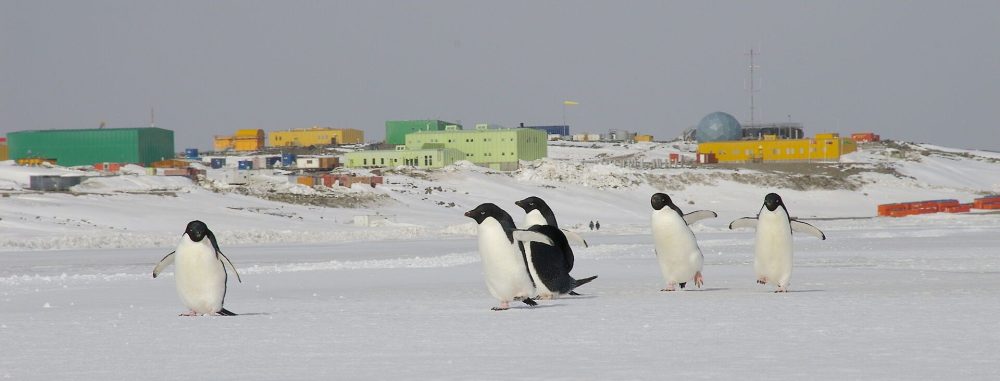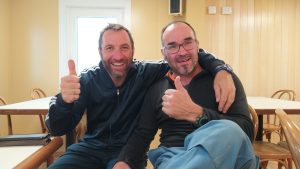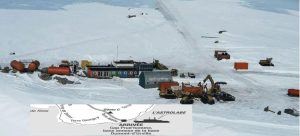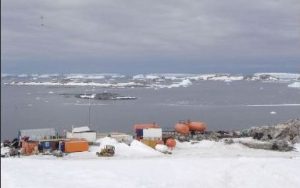 |
 David FT4YM (FT4YM) will be QRV again from Antarctica during the next summer campaign (December 2022 to March 2023).
David FT4YM (FT4YM) will be QRV again from Antarctica during the next summer campaign (December 2022 to March 2023).
Pic aside show David FT4YM and Danilo IZ1KHY, last season at Concordia Station
Although it’s too early to know his exact calendar, David is on the list as driver-mechanic for one of the three convoys that will connect Cap Prud’homme (WAP MNB-NEW) to Little Dome C (WAP MNB-15) via Concordia (WAP MNB-Ø3) on both ways.
During the period, activity is forseen from the following bases:
FT4YM: Base Dumont d’Urville, Petrels island. (WAP FRA-Ø1)
FT4YM/P: Base Concordia.
FT4YM/P: Base Little Dome C.
FT4YM/P: Robert Guillard Station at Cap Prud’homme (aka Base Cape Prud’homme).
As soon as David FT4YM/P will be on air from this brand new Base, a new WAP reference will be issue.
The French radio amateur Polar Team, provides a complete station to take part in the Odyssey on the air. It comprises a Huttenberg HT2000 generator, a Yaesu FT891 transceiver, an Alinco DM330 power supplì. This year, an Icom IC2KL amplifier, a fibr glass mast, a 20/40m wire vertical antenna and other supplies, will be part of David’s set up in Antarctica.
TNX Mehdi, F5PFP
 Cape Prud’homme (Cape Prud’Homme WAP MNB-NEW – W.A.P. (waponline.it)) is a French-Italian Station managed by the (French Polar Institute Paul-Emile Victor (IPEV) and the Programma Nazionale di Ricerche in Antartide (PNRA). Cape Prud’homme is acually WAP MNB-NEW on WAP-WADA Directory. Located on the Antarctic coast, Cap Prud’Homme houses the small Robert Guillard Station, capable of accommodating up to a maximum of 18 people, the tunnels where the tractors and machinery necessary for the traverse are housed and, of course, the material destined for Concordia, which arrives in Antarctica with the Polar French ship Astrolabe, near the French station Dumont D’Urville, which is just 5 km away.
Cape Prud’homme (Cape Prud’Homme WAP MNB-NEW – W.A.P. (waponline.it)) is a French-Italian Station managed by the (French Polar Institute Paul-Emile Victor (IPEV) and the Programma Nazionale di Ricerche in Antartide (PNRA). Cape Prud’homme is acually WAP MNB-NEW on WAP-WADA Directory. Located on the Antarctic coast, Cap Prud’Homme houses the small Robert Guillard Station, capable of accommodating up to a maximum of 18 people, the tunnels where the tractors and machinery necessary for the traverse are housed and, of course, the material destined for Concordia, which arrives in Antarctica with the Polar French ship Astrolabe, near the French station Dumont D’Urville, which is just 5 km away.
More about Cap Prud’homme
 On the mainland, 5 km from the Island of Petrels, DDU (Dumont D’Urville) is articulated to a third place, Robert Guillard (Cap Prud’homme), the basic element of a system whose main objective is to organize, depending on the year, in addition to scientific expeditions, two or three raids to supply fuel and equipment to the Franco-Italian station Concordia.
On the mainland, 5 km from the Island of Petrels, DDU (Dumont D’Urville) is articulated to a third place, Robert Guillard (Cap Prud’homme), the basic element of a system whose main objective is to organize, depending on the year, in addition to scientific expeditions, two or three raids to supply fuel and equipment to the Franco-Italian station Concordia.
Prud’homme is a small unit, from 10 to 20 people depending on the moment, and which is defined as “a village”, administered by an “elder”, named with a touch of humor, the “mayor”. An unelected mayor, without specific status, but simply considered, thanks to his experience, as responsible for the coordination of a team of men and women.
The village is composed mainly of mechanics in charge of preparing and accompanying the raid, a real physical feat, 20 days of crossing round trip across the icy continent, in tractors pulling containers mounted on skis, loaded with tanks of fuel and equipment. It is a real umbilical cord without which Concordia built at 3,200 meters above sea level and 1,200 km from the coast could not live.
 David
David
FT4YM (FT4YM) sera à nouveau QRV depuis l’Antarctique lors de la prochaine campagne d’été (de décembre 2022 à mars 2023).
Photo à côté de l’émission David FT4YM et Danilo IZ1KHY, la saison dernière à la Gare Concordia
Bien qu’il soit trop tôt pour connaître son calendrier exact, David est sur la liste comme chauffeur-mécanicien pour l’un des trois convois qui relieront Cap Prud’homme
(WAP MNB-NEW) vers Little Dome C (WAP MNB-15) via Concordia (WAP MNB-Ø3) dans les deux sens.
Au cours de la période, l’activité est prévue à partir des bases suivantes :
FT4YM : Base Dumont d’Urville, île aux Pétrels. (WAP FRA-Ø1)
FT4YM/P : Base Concordia.
FT4YM/P : Base Petit Dôme C.
FT4YM/P : Station Robert Guillard à Cap Prud’homme (alias Base Cap Prud’homme).
Dès que David FT4YM/P sera en ondes depuis cette toute nouvelle Base, une nouvelle référence WAP sera émise.
L’équipe Polar France radioamateur, met à disposition une station complète pour participer à l’Odyssée sur les ondes. Il comprend un générateur Huttenberg HT2000, un émetteur-récepteur Yaesu FT891, une alimentation Alinco DM330. Cette année, un amplificateur Icom IC2KL, un mât en fibre de verre, une antenne verticale filaire de 20/40 m et d’autres fournitures feront partie de l’installation de David en Antarctique.
TNX Mehdi, F5PFP

Cape Prud’homme (Cape Prud’Homme WAP MNB-NEW – W.A.P. (waponline.it)) est une station franco-italienne
géré par l’Institut Polaire Français Paul-Emile Victor (IPEV) et le Programma Nazionale di Ricerche in Antartide (PNRA). Cape Prud’homme est actuellement WAP MNB-NEW sur WAP-WADA
Annuaire. Situé sur la côte antarctique, Cap Prud’Homme abrite la petite Station Robert Guillard,
pouvant accueillir jusqu’à 18 personnes maximum, les tunnels où sont logés les tracteurs et les engins nécessaires à la traversée et, bien sûr, le matériel destiné à Concordia,
qui arrive en Antarctique avec le navire polaire français Astrolabe, près de la station française Dumont D’Urville, qui est à seulement 5 km.
Plus à propos Cap Prud’homme
 Sur le continent, à 5 km de l’Ile des Pétrels, DDU (Dumont D’Urville) s’articule à un troisième lieu, Robert Guillard ( Cap Prud’homme), élément de base d’un dispositif dont l’objectif principal est d’organiser, selon les années, en plus des expéditions scientifiques, deux ou trois raids pour ravitailler en carburant et en matériel la station franco-italienne Concordia .
Sur le continent, à 5 km de l’Ile des Pétrels, DDU (Dumont D’Urville) s’articule à un troisième lieu, Robert Guillard ( Cap Prud’homme), élément de base d’un dispositif dont l’objectif principal est d’organiser, selon les années, en plus des expéditions scientifiques, deux ou trois raids pour ravitailler en carburant et en matériel la station franco-italienne Concordia .
Prud’homme est une petite unité, de 10 à 20 personnes selon les moments, et qui se définit comme « un village », administré par un « ancien », nommé avec une touche de humour, le ‘maire’. Un maire non élu, sans statut particulier, mais simplement considéré, grâce à son expérience, comme responsable de la coordination d’une équipe d’hommes et de femmes.
Le village est composé principalement de mécaniciens chargés de préparer et d’accompagner le raid, une véritable prouesse physique, 20 jours de traversée aller-retour à travers le continent glacé, en tracteurs tractant des containers montés sur skis, chargés de réservoirs de carburant et de matériel . C’est un véritable cordon ombilical sans lequel Concordia bâtie à 3 200 mètres d’altitude et à 1 200 km des côtes ne pourrait vivre.
Info de la Source Publié * ICI
